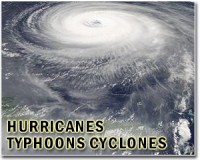 |
Port-Au-Prince (AFP) Nov 6, 2010 Haitians were mopping up the muddy wreckage left by Hurricane Tomas Saturday, amid fears that flooding left by the killer storm will worsen a cholera epidemic that has killed more than 500 people so far. The Haitian Health Ministry reported that the death toll has now climbed to 501, from 442 just three days ago, and that 7,359 people have been hospitalized with the disease. The Artibonite River, believed to be a prime source of the cholera epidemic, was flooding Saturday, swollen by the heavy rains dumped by Tomas as it swept across the impoverished country with hurricane force on Friday. Marianna Franco, an official with the French aid group Acted, said the river's flooding was "bad news because it has been particularly affected by cholera." Still, Haitians emerged from Tomas with less material damage than feared, particularly in the teeming refugee camps of Port-au-Prince, where 1.3 million people have been living since an earthquake in January that killed 250,000 people. "In the end, the day was calmer than expected," said Franco. "There was a bit of rain and wind everywhere but not as bad as expected." Andrea Koppel of the American Red Cross also said the storm's impact was less severe than expected. "Most of the tarps and tents that we saw had not been torn," she told CNN, warning however that residents may find "much more damage" as they ventured out of their shelters. Health officials and aid groups worried that the flooding may exacerbate a cholera epidemic in the northern part of the country, with the disease contracted in part after people drank infected river water. "Dangerous landslides and heavy flooding could still worsen the cholera epidemic. Stay vigilant," urged President Rene Preval on Friday. Koppel said aid groups had readied tarps, tents, blankets and other emergency supplies around the country. They were also delivering fresh water to at least a quarter million people each day in Port-au-Prince tent communities. In the capital Port-au-Prince, people were up to their ankles in water, wading through mud as they carried potable water and other supplies to cramped living quarters in the huge refugee camps. The southern town of Leogane, which was 60 percent destroyed in the January quake, was completely under water. Television images showed people wading through flooded streets. "We are going to have more victims because of the floods and mudslides, but we cannot yet reach the communities most affected," civil defense official Philippe Joseph told AFP. But the canvas and tarpaulin shelters that hundreds of thousands of people call home appeared to have withstood the storm better than expected, thanks to pre-storm preparations including hastily dug drainage ditches and sandbag barriers. The government said it had taken steps to accommodate as many as 100,000 people in schools, churches and hospitals -- a fraction of those left homeless by the earthquake. In the neighboring Dominican Republic, which shares the island of Hispaniola with Haiti, heavy rain from Tomas left 39 communities isolated and forced more than 12,000 people to leave their homes. However no victims were reported. And in nearby Cuba, officials said despite coastal flooding, landslides and moderate infrastructure damage, no casualties were recorded on the island. All coastal watches and warnings were discontinued but the storm system still dumped heavy rain over portions of Puerto Rico and the Turks and Caicos Islands. Schools, airports, and banks were shuttered in Turks and Caicos Islands, but a hurricane watch was lifted at noon Saturday and Governor Gordon Wetherell said an aerial assessment of the islands showed no serious damage. Tomas regained hurricane status late Saturday as it headed into the open Atlantic where it no longer posed threat to land, the Miami-based National Hurricane Center reported. At 0000 GMT Sunday the center of Tomas was located 658 miles (1,058 kilometers) east of Miami, heading north-east at 24 kilometers (15 miles) per hour. Tomas's maximum sustained winds had increased to 120 miles (75 kilometers) per hour, making it a category one hurricane on the five-level Saffir-Simpson scale, the NHC said.
Share This Article With Planet Earth
Related Links Bringing Order To A World Of Disasters When the Earth Quakes A world of storm and tempest
 Hurricane Tomas moves north after killing six in Haiti
Hurricane Tomas moves north after killing six in HaitiPort-Au-Prince (AFP) Nov 6, 2010 Hurricane Tomas moved toward the Turks and Caicos Islands early Saturday after killing six people in Haiti and lashing the poorest country of the hemisphere with fierce winds and rain. But it appeared to have spared the hundreds of thousands of Haitians who rode out the storm in flimsy tent camps. Rains continued off and on for hours after the storm moved on to Cuba, and flooding cut of ... read more |
|
| The content herein, unless otherwise known to be public domain, are Copyright 1995-2010 - SpaceDaily. AFP and UPI Wire Stories are copyright Agence France-Presse and United Press International. ESA Portal Reports are copyright European Space Agency. All NASA sourced material is public domain. Additional copyrights may apply in whole or part to other bona fide parties. Advertising does not imply endorsement,agreement or approval of any opinions, statements or information provided by SpaceDaily on any Web page published or hosted by SpaceDaily. Privacy Statement |